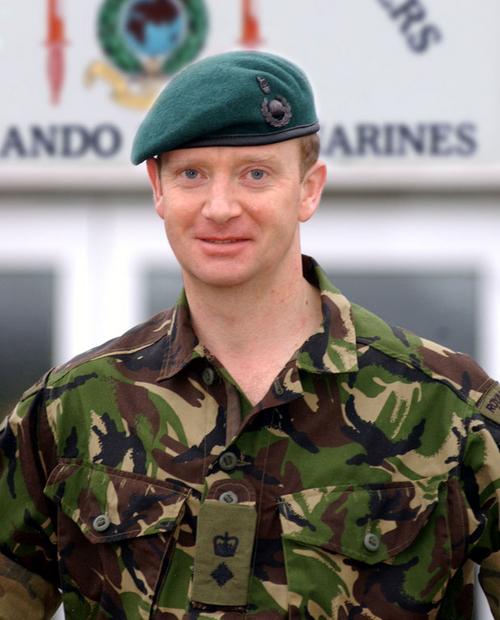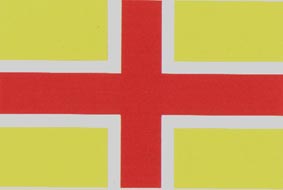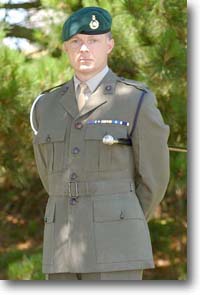42 Commando RM
42 Commando Royal Marines is based at Bickleigh Barracks a few miles outside Plymouth in Devon. The Unit was formed in August 1943 during the Second World War and moved to its present location on 16 September 1971.
A Short History of 42 CDO RM & Bickleigh Barracks
Bickleigh Camp was built by A French & Co. in early 1940. The site was originally designated as a sewage disposal farm, but the Plymouth Emergency Hostels Society needed an evacuee camp; in fact the first occupants were Free French and Polish servicemen.
The following year the camp was taken over by the Canadian Fire Fighting Service until the end 1942 when it was returned to the Civil Defence Organisation for its original purpose of housing refugees. The camp was called the General Evacuation Centre (South West).
By the end of the war Polish Naval personnel once again occupied the camp but it was empty when the first Royal Marines arrived, namely the advanced elements of 27 (RM) Training Battalion in 1945.
In Burma during January 1945, following the capture of the Myebon Peninsular, 3 Commando Brigade was given the task of making a further landing near Kangaw, with the intention of cutting Japanese lines of withdrawal down the coast.
On 22 January 1945, 42 Royal Marines Commando (Lt Col H H Dales) together with No 1 Commando landed and occupied positions in the mangrove swamp.
Subsequently the Commando was ordered to capture a heavily wooded ridge known as Hill 70. Two days of hand-to-hand fighting were necessary before the Japanese could be driven from the ridge, and no sooner were they dislodged than they subjected it to heavy artillery fire.
After a lull of several days, the Japanese counterattacked at dawn on 31 January 1945. The enemy attacked repeatedly. In spite of heavy casualties to the Commando, the Japanese were finally beaten off and withdrew leaving their dead lying thickly among forward Commando positions.
In a Special Order of the Day to 3 Commando Brigade, Lt Gen Sir Philip Christison, Commander of XV Corps, concluded. "The Battle of Kangaw has been the decisive battle of the whole Arakan campaign, and that it was won was very largely due to your magnificent defence of Hill 170".
On 1 April 1946 an Infantry Training Cadre was established, part of the Royal Marines Training Group (Devon), and the camp soon developed into the Infantry Training School with Officer Cadet Training Wing, a Commando School and Cliff Assault Wing (base at St. Ives).
In 1950 Bickleigh was redesignated the Commando School Royal Marines, which it remained until 1960 when the school moved to Lympstone.
The value of Bickleigh as a military training area lies in its close proximity to Dartmoor, with its ideal training areas and ranges, coupled with its proximity to Plymouth for easy maritime access. However, during the 1950's, despite continuing as the Royal Marines Commando School, a number of operational tasks fell to its occupants.
The government decided to send a small Commando Force when the Korean War broke out. 41 (Independent) Commando Royal Marines, which formed up at Bickleigh on 16 August 1950, included many members of the staff. This unit disbanded at the Royal Marines Barracks Stonehouse on 22 February 1952.
In September 1954, 42 Commando returned to the UK after the draw-down of the British forces in Malta, and remained there as an operational nucleus till they were reactivated to become the first commando to embark in a Commando Carrier, HMS Bulwark in March 1960.
During the intervening years, the unit was brought up to strength for the Suez crisis, rejoining 3 Commando Brigade in Malta and was the initial landing force across the beaches of Port Said in November 1958 for the Lebanon crisis.
It was during this time that the decision was taken to move the Commando School to the newly developed Lympstone and in early 1960 the school redeployed there, just in time to allow Bickleigh to be used for the deactivation of 41 Commando. This unit formed on 31 March 1960 and remained there as part of the UK Strategic Reserve, taking part in exercises as far away as Norway and the West Indies. It was operationally deployed to Tanganyika and Kenya in February 1964 returning to Bickleigh on 7 April.
A large redevelopment programme got under way that year; the wooden and nissen huts were replaced by a permanent brick barracks, which was finally completed in 1971. By this time 41 Commando, having carried out two operational tours in Northern Ireland, moved to Malta as garrison troops on 3 September 1971. This coincided with the withdrawal of 3 Commando Brigade from the Far East and 42 Commando once again took over occupation of Bickleigh, where they have remained until this day.
During the initial landings on the Falkland Islands on 21 May 1982, 42 Commando RM (Lt Col N F Vaux RM) were Brigade Reserve at Port San Carlos, before seizing Mount Kent in a night move by helicopter. By 4 June the unit had moved forward, mostly under cover of darkness, to positions west of high ground overlooking Stanley and the last Argentine stronghold. After days of probing reconnaissance, a Brigade assault took place on the night of 11/12 June in which the Commando's task was to secure Mount Harriet on the Brigade right flank.
By moonlight and in freezing temperatures, 42 Commando moved undetected through enemy minefields in a 9 kilometre right-flanking movement to surprise the enemy in their rear. Consecutive assaults by "K" and "L" Companies followed, up steep slopes onto company positions amongst the crags at either end of the feature. Careful planning, resolute leadership and the boldness and determination of marines against initially strong resistance and continuous artillery bombardment, eventually prevailed. By first light more than 30 enemy had been killed and over 300 prisoners taken as 42 Commando consolidated on Mount Harriet.
Apart from many operational deployments to Northern Ireland, deploying troops to the New Hebrides in 1980 and exercising regularly overseas, the commando has recently seen operational service in South Georgia, Montserratt in 1995 and South Armagh in 1998/99.
COMMANDING OFFICER
 Lieutenant Colonel Matt Holmes RM
Lieutenant Colonel Matt Holmes RM
Lieutenant Colonel Matt Holmes joined the Royal Marines in 1988, after reading economics at Exeter University. Initial appointments included Troop Commander at 42 Commando RM, Recruit Troop Officer at the Commando Training Centre, and Unit Training Officer at 40 Commando RM. During his spell at ‘40’, he also served as a Company Second-in-Command on Operation Banner in West Belfast. After Junior Staff College, he served in Arbroath as the Operations Officer for 45 Commando Group, as the Unit inherited the first high readiness Spearhead Land Element role and undertook a Far East jungle deployment to Brunei, followed by a deployment to Zimbabwe. He returned to 42 Commando RM to assume command of Kilo Company and completed his third winter deployment to Norway and an Operation Banner tour, this time to South Armagh. He was promoted to Major whilst in command.
Advanced Command and Staff College and a Masters Course beckoned in 2000. On completion, he returned to 3 Commando Brigade RM, for a busy spell as the Brigade Operations Officer. He completed Operation Agricola in Kosovo and deployed on the Joint exercise, Ex Saif Sareea II, in 2001. The Brigade commenced operations in Afghanistan shortly after this exercise, and he subsequently deployed on Operation Jacana in 2002 before promotion to Lieutenant Colonel and assumption of a post in the Ministry of Defence in October, within the Directorate of Overseas Military Activity. He oversaw West Africa and Operation Keeling in Sierra Leone in this capacity. In May 2003, he moved to the Permanent Joint Headquarters as SO1 J3 (Maritime/Amphibious), and assumed the role of UN Operations Team Leader. During this time, he led the Operations Team for Operation Coral in the DRC, the first autonomous EU Operation. He took over as Operational Team Leader for the Balkans in March 2004 and almost immediately launched Operation Mercian, the Spearhead Land Element deployment to Kosovo as part of NATO’s emergency request for operational reserves.
In November 2004, Lieutenant Colonel Holmes joined COMUKAMPHIBFOR as the Operations Officer for this 2* Headquarters, during which time he deployed to Iraq on Operation Telic as Chief J5 Plans for the Headquarters of the Multi-National Division (South East) in Basra.
He assumed command of 42 Commando RM on 27 March 2006.
Lieutenant Colonel Holmes is married to Lea and they have a young daughter. They live in Hampshire and share interests in travel, ski-ing and water sports, in particular SCUBA diving.
WO1(RSM)
Marc Wicks was born in Devon and educated at Audley Park Secondary Modern School in Torquay. He joined the Royal Marines Commandos in March 1983. After successfully completing training he was drafted to 42 Commando in Plymouth. Whilst serving with 42 Commando he was promoted to Lance Corporal. He completed numerous tours in Norway and was selected to become a Military Ski Instructor. In 1984 he deployed to Northern Ireland with 42 Commando Royal Marines, on Operation BANNER. He was then drafted to Commachio Group Royal Marines. In 1987 he attended the Junior Command Course at Commando Training Center Royal Marines. On completion of this course he returned to Scotland where he was promoted to Corporal and took up the responsibility of a section commander. He then volunteered to return to Northern Ireland to work on Operation Internet. Cpl Wicks spent over two years on this tour and was awarded the General Officer Commanding Northern Ireland commendation.
In 1991 he decided to become a Physical Training Instructor and after sixteen weeks on course he graduated as the top student and was awarded the Straghan Trophy. He immediately became a recruit troop PTI, and passed two troops out of training.
On successful completion of the Senior Command Course he attended the Joint Services Remedial Instructor Course in London at the Queen Elizabeth Medical Hospital. He was then drafted to 42 Commando again, where he took over as the Troop Sergeant for One Troop, K Company. During his time at 42 Commando he served in Norway and on his return, took up the position of the Unit Physical Training Instructor.
He then attended a Physical Training Instructor First Class Course. Where once again he graduated as the top student and received the Kelland Trophy. On completion of this course he took over as the head of department of the remedial instructors. He was then chosen to become a Staff Physical Training Instructor, responsible for the selection, administration, training and conduct of physical training courses. After two exhilarating years, he was selected in 1998 to become the Physical Training Advisor at Officer Candidate School, USMC, in Quantico, Virginia, where he was awarded the Navy and Marine Corp Commendation Medal for his services. In 2000 he returned to the UK and attended the Advance Command Course. He was promoted to Warrant Officer 2nd Class and took over at 3 Commando Brigades Headquarters and Signals Squadron as the Squadron Sergeant Major. When the unit was renamed to the United Kingdom Landing Force Command Support Group he changed roles and became the Brigade Reconnaissance Force Sergeant Major where he served in the Oman. Afterwards he became the Logistics Squadron Sergeant Major and deployed to Afghanistan and Iraq on Operations JACANA and TELIC.
In 2003 WO2 Wicks became the Physical Training Troop Sergeant Major and Chief Instructor at the Commando Training Centre Royal Marines. After successfully passing the WO1 (RSM) Board and completing the subsequent course, he was appointed as the Regimental Sergeant Major of 42 Commando Royal Marines on the 03 March 2005.
He has represented both Corps and Great Britain in the sport of Dragonboating and remains as fit and healthy as time allows.
WO1 Wicks is married to Eileen, has two daughters and is still living in the South West of England.

